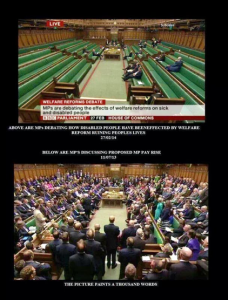This blog post was published under the 2017 – 2019 Conservative government
By Jake Butterworth, Prevent Education Officer (London Borough of Hammersmith & Fulham / The Royal Borough of Kensington and Chelsea)
In the images below we see a stark contrast between a handful of politicians reportedly talking about welfare reforms and a packed room for a debate on MP pay. Is this showing that politicians are primarily self-serving? The comparison is certainly emotive.
However, it also shows how easily images can be manipulated to serve particular narratives – regardless of what really happened. The Spectator looked into these images and revealed that the packed room photo was actually taken at Prime Minister’s Questions – a debate on pay didn’t even take place on the date cited in the caption!
Over the last few years, these and similar images have been shared across social media, with many posts going unchallenged. Social media is the most prominent source of fake news as well as the most popular source of news for children.[1]Fake news and conspiracy theories can be used by extremist groups to promote grievances and mistrust, ultimately meaning that victims are more susceptible to their own extremist ideology. On the other hand, teaching media literacy in the classroom can help ensure that children are more resilient to extremism, by helping them look more critically at imagery and stories which appear to be news articles.[2]
As part of my role as a Prevent Education Officer, I work with schools to ensure that they have the knowledge, resources and ability to use existing opportunities within the curriculum to explore extremism and related topics in a safe space. This may be having age-appropriate lessons or assemblies on extremism or terrorism, but also on other broader topics to do with Fundamental British Values (e.g. tolerance), online safety, and media literacy.
I recently attended some excellent training on media literacy in the classroom, which was hosted by the US Embassy and delivered by Damaso Reyes of the News Literacy Project. The training highlighted some examples of fake news, outlined how the News Literacy Project has some excellent (US-focused) resources to aid teaching of media literacy and gave a suggested framework on how children can be more media literate and therefore have the skills necessary to recognise fake news. It was advised that the following seven steps should be undertaken when viewing a piece of news:
- Check your emotions – what’s your reaction?
- Determine the purpose of what you are reading, watching or hearing
- Be aware of your biases
- Consider the message – content and style
- Search for more information
- Find out more about the source
- Research the content itself
Fake news can regularly be found covering a myriad of topics so there will be opportunities across the curriculum for students to practice these steps. Next time you come across potential fake news, consider whether the story could be investigated with your class – or encourage pupils to collect examples of fake news and share which features made them suspicious.
For more ideas on teaching about fake news in class, the Full Fact toolkit hosts lesson plans on fact checking for 114-16-year-olds meanwhile, Childnet has produced the Trust Me primary and secondary resource packs to teach students the skills to assess online content.
[1]http://www.bbc.co.uk/news/uk-36528256
[2]https://ec.europa.eu/home-affairs/sites/homeaffairs/files/what-we-do/networks/radicalisation_awareness_network/about-ran/ran-edu/docs/ran_edu_dealing_fake_news_conspiracy_theories_propaganda_classroom_29-30_11_2017_.pdf?utm_content=bufferf09d0&utm_medium=social&utm_source=twitter.com&utm_campaign=buffer


